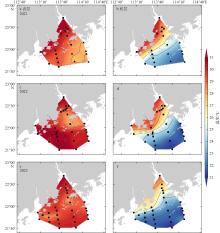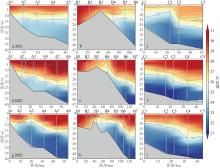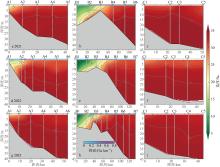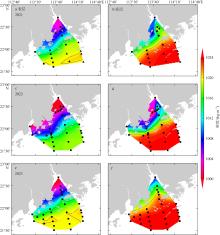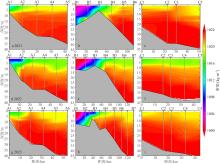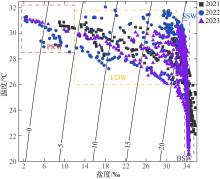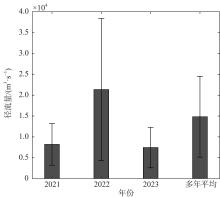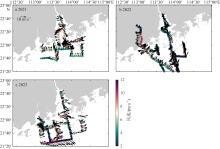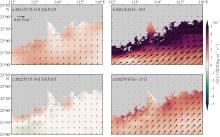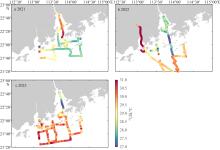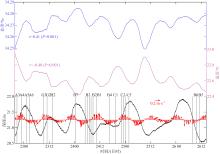Journal of Tropical Oceanography ›› 2025, Vol. 44 ›› Issue (1): 108-121.doi: 10.11978/2024042CSTR: 32234.14.2024042
• Marine Hydrology • Previous Articles Next Articles
Summer hydrological variations during 2021-2023 in the Pearl River Estuary and its adjacent areas
GUO Shaojing1( ), ZHANG Xiaobo1, CHANG Jinglong1, ZHANG Shouwen1, JI Xuanliang2, MIAO Runqiao1, LI Jiandong1, ZHU Xueming1(
), ZHANG Xiaobo1, CHANG Jinglong1, ZHANG Shouwen1, JI Xuanliang2, MIAO Runqiao1, LI Jiandong1, ZHU Xueming1( )
)
- 1. School of Marine Sciences, Sun Yat-sen University, Southern Marine Science and Engineering Guangdong Laboratory (Zhuhai), Zhuhai 519082, China
2. National Marine Environmental Forecasting Center, Ministry of Natural Resources, Beijing 100081, China
-
Received:2024-02-22Revised:2024-03-18Online:2025-01-10Published:2025-02-10 -
Contact:ZHU Xueming -
Supported by:Southern Marine Science and Engineering Guangdong Laboratory (Zhuhai)(SML2023SP219); National Natural Science Foundation of China(42176029)
CLC Number:
- P731
Cite this article
GUO Shaojing, ZHANG Xiaobo, CHANG Jinglong, ZHANG Shouwen, JI Xuanliang, MIAO Runqiao, LI Jiandong, ZHU Xueming. Summer hydrological variations during 2021-2023 in the Pearl River Estuary and its adjacent areas[J].Journal of Tropical Oceanography, 2025, 44(1): 108-121.
share this article
Add to citation manager EndNote|Reference Manager|ProCite|BibTeX|RefWorks

Fig. 1
Map of the Pearl River and distribution of observed stations in the summer during 2021−2023. The contours and shading in the inset indicate water depth. The black dotted line in the inset represents track of Typhoon Lupit in 2021, and observed stations before and after Lupit passed are marked in red and purple circles, respectively"

Tab. 1
Mean and standard deviation of hydrological parameters during investigations from 2021 to 2023"
| 年份 | 海温/℃ | 盐度/‰ | 密度/(kg·m-3) | |||
|---|---|---|---|---|---|---|
| 表层 | 底层 | 表层 | 底层 | 表层 | 底层 | |
| 2021 | 29.4±1.1 | 25.4±2.9 | 24.7±8.5 | 31.1±5.6 | 1014.3±6.7 | 1020.4±5.1 |
| 2022 | 30.4±1.1 | 24.8±3.1 | 20.4±10.1 | 28.2±9.4 | 1010.7±7.4 | 1018.4±7.9 |
| 2023 | 29.6±0.8 | 23.1±2.1 | 28.4±7.1 | 33.2±3.4 | 1016.9±5.3 | 1022.7±3.1 |
| [1] |
陈希荣, 朱佳, 孙振宇, 等, 2018. 2015年7—8月珠江冲淡水扩展特征的观测与分析[J]. 厦门大学学报(自然科学版), 57(6): 841-848.
|
|
|
|
| [2] |
林卫强, 李适宇, 2002. 夏季伶仃洋COD、DO的垂向分布及其影响因素[J]. 中山大学学报(自然科学版), 41(4): 82-86.
|
|
|
|
| [3] |
林祖亨, 梁舜华, 1996. 珠江口水域的潮流分析[J]. 海洋通报, 15(2): 11-22.
|
|
|
|
| [4] |
毛汉礼, 甘子钧, 蓝淑芳, 1963. 长江冲淡水及其混合问题的初步探讨[J]. 海洋与湖沼, 5(3): 183-206.
|
|
|
|
| [5] |
宋晓飞, 石荣贵, 孙羚晏, 等, 2014. 珠江口磨刀门盐水入侵的现状与成因分析[J]. 海洋通报, 33(1): 7-15.
|
|
|
|
| [6] |
伍伯瑜, 1990. 珠江口以西陆架海域环流研究Ⅲ[J]. 台湾海峡, 9(2): 118-126.
|
|
|
|
| [7] |
夏华永, 刘长建, 王东晓, 2018. 2006年夏季珠江冲淡水驱动的上升流[J]. 海洋学报, 40(7): 43-54.
|
|
|
|
| [8] |
夏维, 周争桥, 2021. 基于观测资料的珠江口附近海域夏季气象水文要素分析[J]. 海洋湖沼通报, 43(5): 60-65.
|
|
|
|
| [9] |
杨威, 罗琳, 高永利, 等, 2011. 1999年和2009年夏季珠江口环境要素的对比与分析[J]. 热带海洋学报, 30(4): 16-23.
|
|
|
|
| [10] |
曾淦宁, 胡建宇, 洪华生, 等, 2005. 西南季风不同阶段南海北部珠江口外断面水文调查分析[J]. 热带海洋学报, 24(3): 10-17.
|
|
|
|
| [11] |
章文, 刘丙军, 陈晓宏, 等, 2013. 珠江口磨刀门水道盐度变化与潮汐过程的相关性分析[J]. 中山大学学报(自然科学版), 52(6): 11-16.
|
|
|
|
| [12] |
张燕, 夏华永, 钱立兵, 等, 2011. 2006年夏、冬季珠江口附近海域水文特征调查分析[J]. 热带海洋学报, 30(1): 20-28.
|
|
|
|
| [13] |
赵焕庭, 1990. 珠江河口演变[M]. 北京: 海洋出版社: 116-147 (in Chinese).
|
| [14] |
朱佳, 胡建宇, 陈照章, 等, 2005. 珠江口以外海域温、盐度的断面分布特征———2001年5月与2002年11月航次[J]. 厦门大学学报(自然科学版), 44(5): 680-683.
|
|
|
|
| [15] |
|
| [16] |
|
| [17] |
|
| [18] |
|
| [19] |
|
| [1] | ZHANG Liangbin, QU Ke, HUANG Jingxuan, WANG Xu, GUO Lei. Numerical simulation study of the influences of onshore wind on overtopping characteristics of coastal seawall under focused wave [J]. Journal of Tropical Oceanography, 2023, 42(6): 63-73. |
| [2] | SONG Xingyu, LIN Yajun, ZHANG Liangkui, XIANG Chenhui, HUANG Yadong, ZHENG Chuanyang. Distribution characteristics and influencing factors of meso- and micro-zooplankton communities in the offshore waters of the Guangdong-Hong Kong-Macao Greater Bay Area* [J]. Journal of Tropical Oceanography, 2023, 42(3): 136-148. |
| [3] | TANG Ling, NIE Yuhua, WANG Ping, TANG Chaolian. Trend analysis of marine heatwaves variability in the outer Pearl River estuary from 1974 to 2020 [J]. Journal of Tropical Oceanography, 2022, 41(6): 143-150. |
| [4] | SHANG Bowen, WU Yunchao, JIANG Zhijian, LIU Songlin, HUANG Xiaoping. Characteristics and sources of organic matter in sediments of the Pearl River Estuary: Carbon storage implications [J]. Journal of Tropical Oceanography, 2022, 41(3): 16-28. |
| [5] | YIN Tianqi, WANG Qing, YANG Yufeng, CEN Jingyi. Comparative study on zooplankton community structure in Pearl River Estuary based on morphological and DNA identification [J]. Journal of Tropical Oceanography, 2022, 41(3): 172-185. |
| [6] | ZENG Dianting, LI Junyi, XIE Lingling, YE Xiaomin, ZHOU Da. Analysis of temporal characteristics of chlorophyll a in Lingding Bay during summer [J]. Journal of Tropical Oceanography, 2022, 41(2): 16-25. |
| [7] | SHUAI Yiping, CHEN Yinchao, LIU Zijia, GE Zaiming, MA Mengzhen, ZHANG Yuanfang, LI Qian. Distribution of Pearl-River diluted water and its ecological characteristics during spring monsoon transitional period in 2016* [J]. Journal of Tropical Oceanography, 2021, 40(5): 63-71. |
| [8] | LAN Xuan, LI Feng, ZHANG Chao, DONG Hanying, YANG Qingshu, YU Minghui, WEN Rubing, YANG Yujie. Ecological risk assessment of thallium in Pearl River Estuary and network based on the SOM model [J]. Journal of Tropical Oceanography, 2021, 40(3): 132-142. |
| [9] | CAI Shuqun, NIU Jianwei, HE Yinghui, CHEN Xuebin, ZHANG Yongkang, XU Jiexin, CHEN Zhiwu, LIN Shicheng, XIE Jieshuo. A view on constructing synchronous real-time in-situ observational system of marine hydrology based on offshore wind power field [J]. Journal of Tropical Oceanography, 2021, 40(3): 96-102. |
| [10] | CAI Jiannan, LIU Hailong, JIANG Bo, CHEN Yinhui, LI Jiehong, WU Sixiao, LIANG Jianxia, HUANG Hua, XING Qianguo. Retrieval of non-optically active water quality parameters by hyperspectra for river network waters in the Pearl River estuary [J]. Journal of Tropical Oceanography, 2021, 40(1): 58-64. |
| [11] | SU Xinying, ZHONG Yu, LI Yao, TAN Meiting, HUANG Yadong, LIU Shan, XU Xiangrong, SONG Xingyu. Distribution characteristics and influencing factors of phytoplankton in waters around typical islands in the Pearl River Estuary* [J]. Journal of Tropical Oceanography, 2020, 39(5): 30-42. |
| [12] | YANG Bifeng, XIONG Cheng, CAO Jinghe, SUN Jinlong, WAN Kuiyuan, XIA Shaohong. Constrains of sliding wave phases on the low-velocity layer in the Pearl River Estuary [J]. Journal of Tropical Oceanography, 2020, 39(1): 106-119. |
| [13] | YAN Dong, SONG Dehai, BAO Xianwen. Spring-neap tidal variation and mechanism analysis of the maximum turbidity in the Pearl River Estuary during flood season [J]. Journal of Tropical Oceanography, 2020, 39(1): 20-35. |
| [14] | Suying OU. Surface suspended sediment distribution of Pearl River estuary under tropical storms with different wind and river discharge forcing [J]. Journal of Tropical Oceanography, 2019, 38(3): 22-31. |
| [15] | Weikang ZHAN,Jie WU,Xing WEI,Shilin TANG,Haigang ZHAN. Quantile trend analysis for suspended sediment concentration in the Pearl River Estuary based on remote sensing [J]. Journal of Tropical Oceanography, 2019, 38(3): 32-42. |
|
||


